Management Accounting Report: Analysis of Financial Planning and Tools
VerifiedAdded on 2022/12/05
|13
|3727
|242
Report
AI Summary
This report provides a comprehensive overview of management accounting, exploring its principles, role, and various techniques. It delves into the significance of financial records, the generation of financial statements (income statement, balance sheet, and cash flow statement), and their use in comparing current financial data with historical information for budget allocation. The report examines the principles of management accounting, including accrual, conservatism, consistency, cost, economic entity, full disclosure, going concern, matching, materiality, monetary unit, reliability, revenue recognition, and time period principles. It also discusses key management accounting techniques such as margin analysis, capital budgeting, inventory valuation, product costing, and trend analysis. Furthermore, the report highlights the importance of planning tools in management accounting, including financial planning, analysis of financial statements, cost accounting, fund flow analysis, and cash flow analysis. The report uses Thomas Swan & Co. Ltd. as a case study to illustrate practical applications of these concepts.
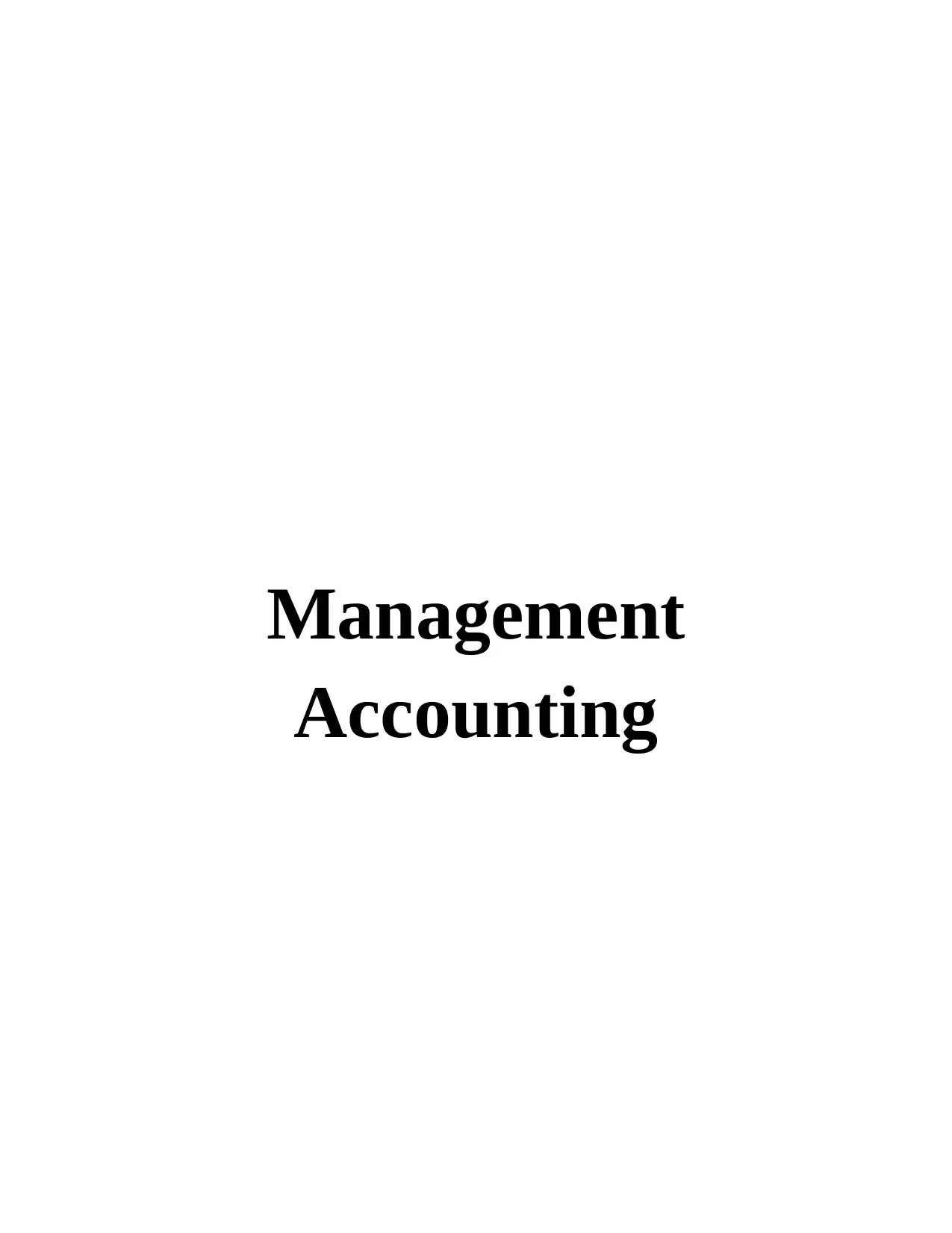
Management
Accounting
Accounting
Paraphrase This Document
Need a fresh take? Get an instant paraphrase of this document with our AI Paraphraser
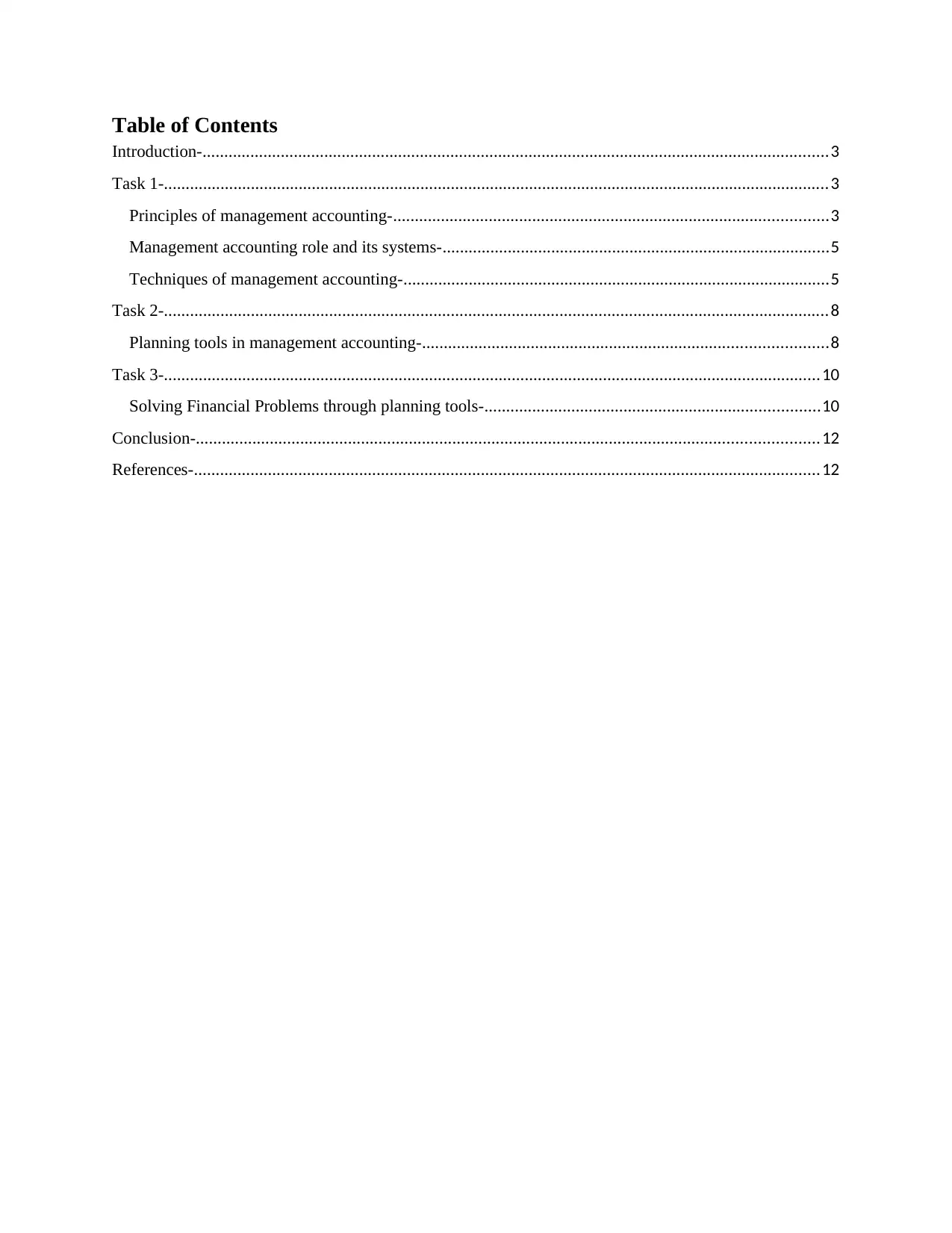
Table of Contents
Introduction-................................................................................................................................................3
Task 1-.........................................................................................................................................................3
Principles of management accounting-....................................................................................................3
Management accounting role and its systems-.........................................................................................5
Techniques of management accounting-..................................................................................................5
Task 2-.........................................................................................................................................................8
Planning tools in management accounting-.............................................................................................8
Task 3-.......................................................................................................................................................10
Solving Financial Problems through planning tools-.............................................................................10
Conclusion-...............................................................................................................................................12
References-................................................................................................................................................12
Introduction-................................................................................................................................................3
Task 1-.........................................................................................................................................................3
Principles of management accounting-....................................................................................................3
Management accounting role and its systems-.........................................................................................5
Techniques of management accounting-..................................................................................................5
Task 2-.........................................................................................................................................................8
Planning tools in management accounting-.............................................................................................8
Task 3-.......................................................................................................................................................10
Solving Financial Problems through planning tools-.............................................................................10
Conclusion-...............................................................................................................................................12
References-................................................................................................................................................12
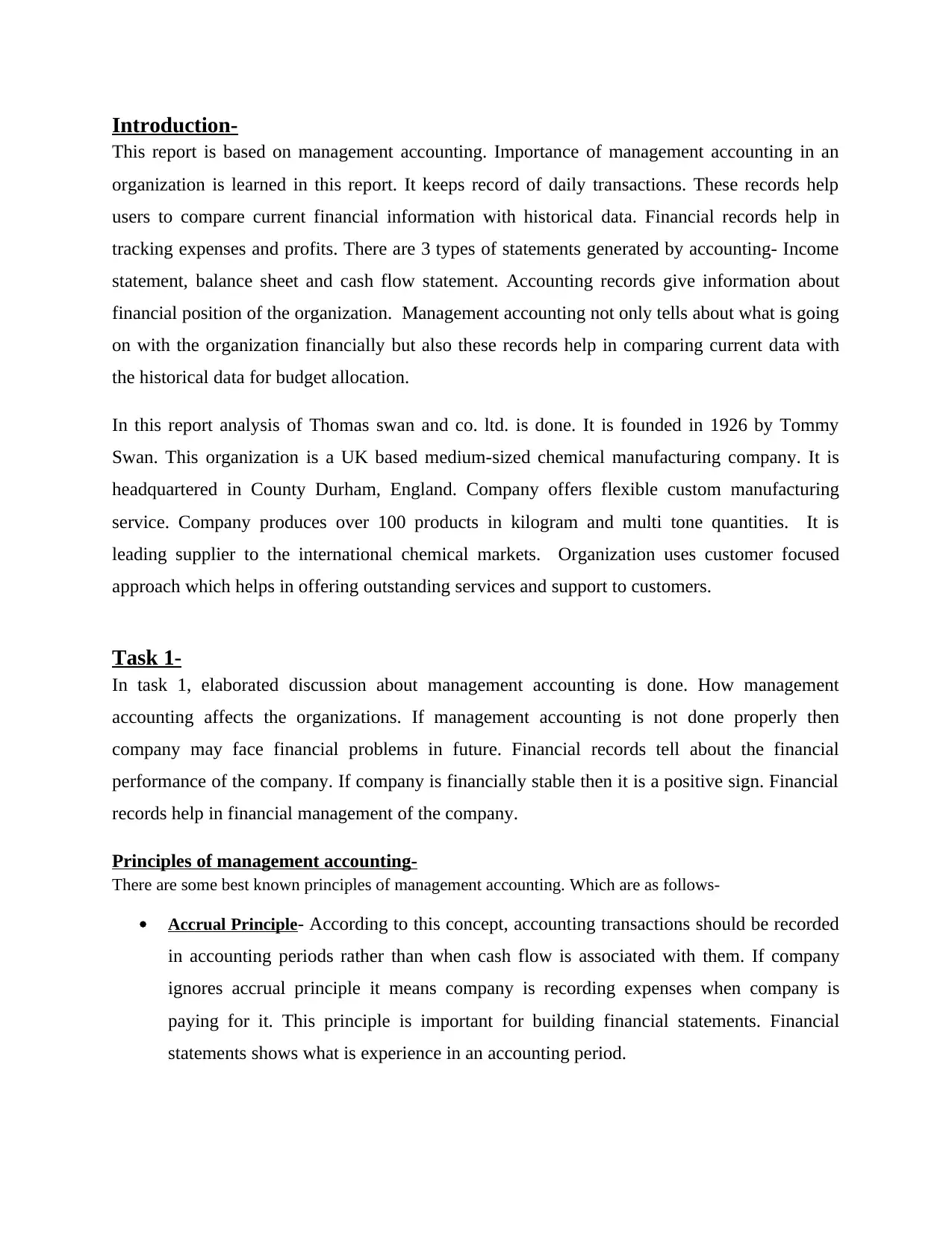
Introduction-
This report is based on management accounting. Importance of management accounting in an
organization is learned in this report. It keeps record of daily transactions. These records help
users to compare current financial information with historical data. Financial records help in
tracking expenses and profits. There are 3 types of statements generated by accounting- Income
statement, balance sheet and cash flow statement. Accounting records give information about
financial position of the organization. Management accounting not only tells about what is going
on with the organization financially but also these records help in comparing current data with
the historical data for budget allocation.
In this report analysis of Thomas swan and co. ltd. is done. It is founded in 1926 by Tommy
Swan. This organization is a UK based medium-sized chemical manufacturing company. It is
headquartered in County Durham, England. Company offers flexible custom manufacturing
service. Company produces over 100 products in kilogram and multi tone quantities. It is
leading supplier to the international chemical markets. Organization uses customer focused
approach which helps in offering outstanding services and support to customers.
Task 1-
In task 1, elaborated discussion about management accounting is done. How management
accounting affects the organizations. If management accounting is not done properly then
company may face financial problems in future. Financial records tell about the financial
performance of the company. If company is financially stable then it is a positive sign. Financial
records help in financial management of the company.
Principles of management accounting-
There are some best known principles of management accounting. Which are as follows-
Accrual Principle- According to this concept, accounting transactions should be recorded
in accounting periods rather than when cash flow is associated with them. If company
ignores accrual principle it means company is recording expenses when company is
paying for it. This principle is important for building financial statements. Financial
statements shows what is experience in an accounting period.
This report is based on management accounting. Importance of management accounting in an
organization is learned in this report. It keeps record of daily transactions. These records help
users to compare current financial information with historical data. Financial records help in
tracking expenses and profits. There are 3 types of statements generated by accounting- Income
statement, balance sheet and cash flow statement. Accounting records give information about
financial position of the organization. Management accounting not only tells about what is going
on with the organization financially but also these records help in comparing current data with
the historical data for budget allocation.
In this report analysis of Thomas swan and co. ltd. is done. It is founded in 1926 by Tommy
Swan. This organization is a UK based medium-sized chemical manufacturing company. It is
headquartered in County Durham, England. Company offers flexible custom manufacturing
service. Company produces over 100 products in kilogram and multi tone quantities. It is
leading supplier to the international chemical markets. Organization uses customer focused
approach which helps in offering outstanding services and support to customers.
Task 1-
In task 1, elaborated discussion about management accounting is done. How management
accounting affects the organizations. If management accounting is not done properly then
company may face financial problems in future. Financial records tell about the financial
performance of the company. If company is financially stable then it is a positive sign. Financial
records help in financial management of the company.
Principles of management accounting-
There are some best known principles of management accounting. Which are as follows-
Accrual Principle- According to this concept, accounting transactions should be recorded
in accounting periods rather than when cash flow is associated with them. If company
ignores accrual principle it means company is recording expenses when company is
paying for it. This principle is important for building financial statements. Financial
statements shows what is experience in an accounting period.
⊘ This is a preview!⊘
Do you want full access?
Subscribe today to unlock all pages.

Trusted by 1+ million students worldwide
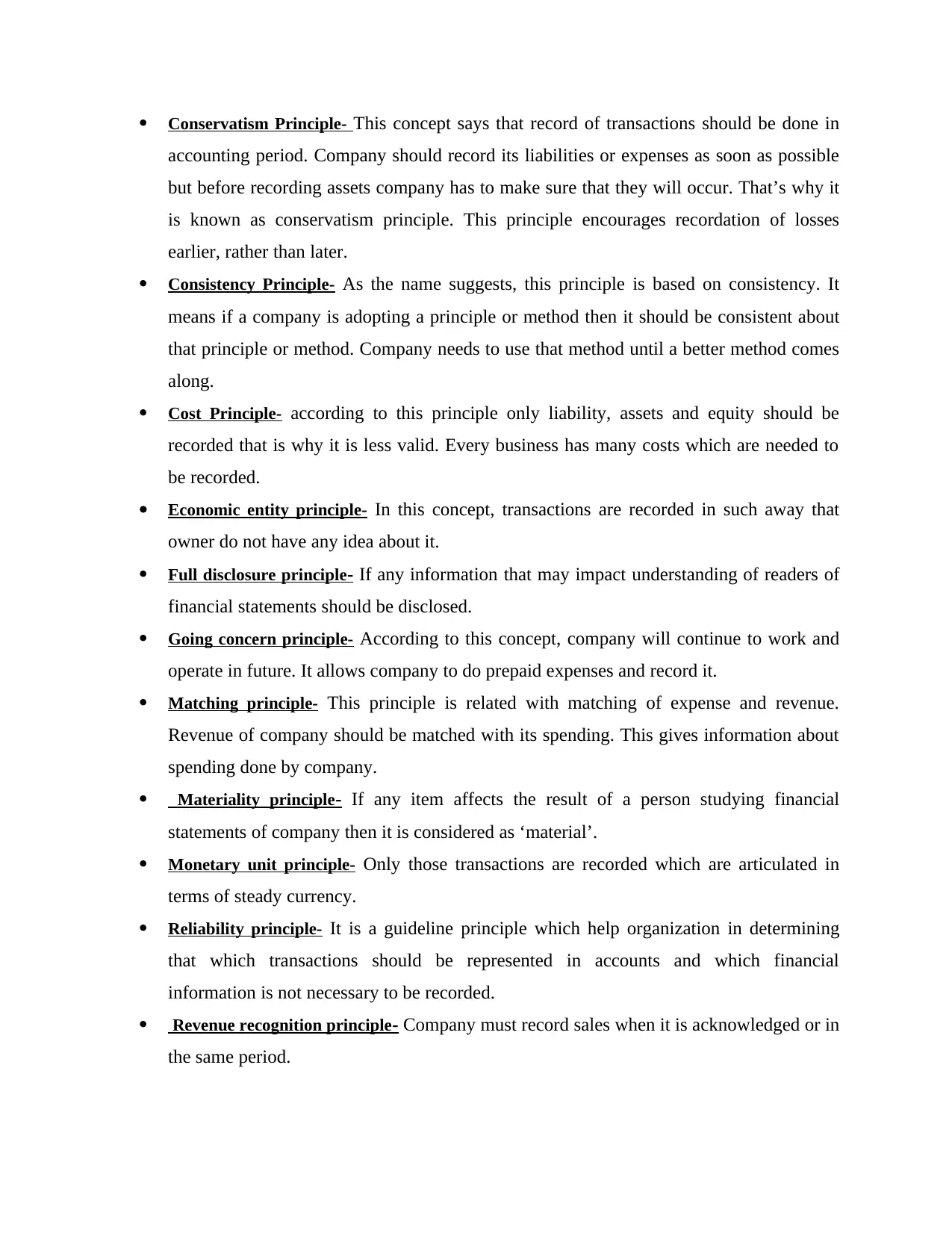
Conservatism Principle- This concept says that record of transactions should be done in
accounting period. Company should record its liabilities or expenses as soon as possible
but before recording assets company has to make sure that they will occur. That’s why it
is known as conservatism principle. This principle encourages recordation of losses
earlier, rather than later.
Consistency Principle- As the name suggests, this principle is based on consistency. It
means if a company is adopting a principle or method then it should be consistent about
that principle or method. Company needs to use that method until a better method comes
along.
Cost Principle- according to this principle only liability, assets and equity should be
recorded that is why it is less valid. Every business has many costs which are needed to
be recorded.
Economic entity principle- In this concept, transactions are recorded in such away that
owner do not have any idea about it.
Full disclosure principle- If any information that may impact understanding of readers of
financial statements should be disclosed.
Going concern principle- According to this concept, company will continue to work and
operate in future. It allows company to do prepaid expenses and record it.
Matching principle- This principle is related with matching of expense and revenue.
Revenue of company should be matched with its spending. This gives information about
spending done by company.
Materiality principle- If any item affects the result of a person studying financial
statements of company then it is considered as ‘material’.
Monetary unit principle- Only those transactions are recorded which are articulated in
terms of steady currency.
Reliability principle- It is a guideline principle which help organization in determining
that which transactions should be represented in accounts and which financial
information is not necessary to be recorded.
Revenue recognition principle- Company must record sales when it is acknowledged or in
the same period.
accounting period. Company should record its liabilities or expenses as soon as possible
but before recording assets company has to make sure that they will occur. That’s why it
is known as conservatism principle. This principle encourages recordation of losses
earlier, rather than later.
Consistency Principle- As the name suggests, this principle is based on consistency. It
means if a company is adopting a principle or method then it should be consistent about
that principle or method. Company needs to use that method until a better method comes
along.
Cost Principle- according to this principle only liability, assets and equity should be
recorded that is why it is less valid. Every business has many costs which are needed to
be recorded.
Economic entity principle- In this concept, transactions are recorded in such away that
owner do not have any idea about it.
Full disclosure principle- If any information that may impact understanding of readers of
financial statements should be disclosed.
Going concern principle- According to this concept, company will continue to work and
operate in future. It allows company to do prepaid expenses and record it.
Matching principle- This principle is related with matching of expense and revenue.
Revenue of company should be matched with its spending. This gives information about
spending done by company.
Materiality principle- If any item affects the result of a person studying financial
statements of company then it is considered as ‘material’.
Monetary unit principle- Only those transactions are recorded which are articulated in
terms of steady currency.
Reliability principle- It is a guideline principle which help organization in determining
that which transactions should be represented in accounts and which financial
information is not necessary to be recorded.
Revenue recognition principle- Company must record sales when it is acknowledged or in
the same period.
Paraphrase This Document
Need a fresh take? Get an instant paraphrase of this document with our AI Paraphraser
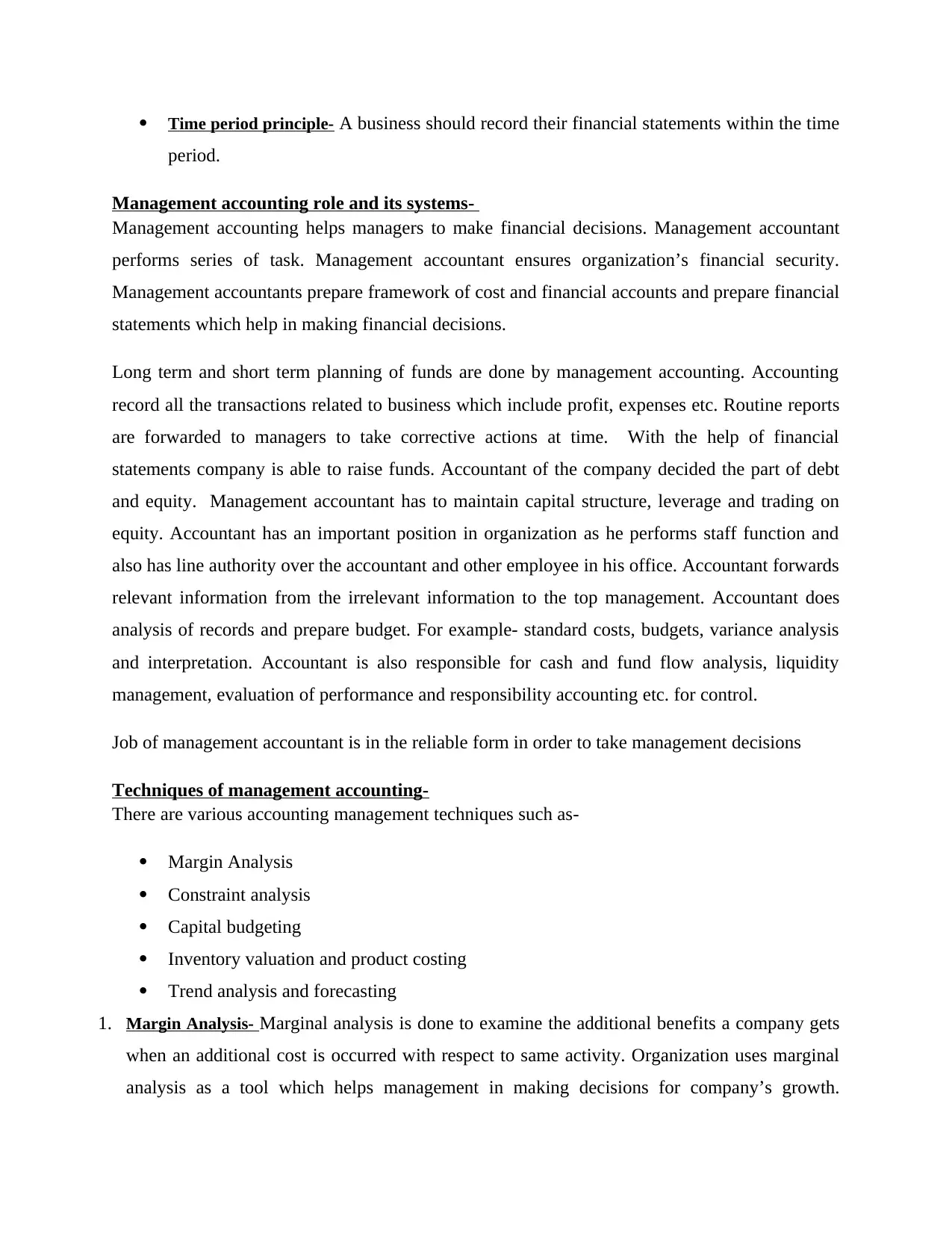
Time period principle- A business should record their financial statements within the time
period.
Management accounting role and its systems-
Management accounting helps managers to make financial decisions. Management accountant
performs series of task. Management accountant ensures organization’s financial security.
Management accountants prepare framework of cost and financial accounts and prepare financial
statements which help in making financial decisions.
Long term and short term planning of funds are done by management accounting. Accounting
record all the transactions related to business which include profit, expenses etc. Routine reports
are forwarded to managers to take corrective actions at time. With the help of financial
statements company is able to raise funds. Accountant of the company decided the part of debt
and equity. Management accountant has to maintain capital structure, leverage and trading on
equity. Accountant has an important position in organization as he performs staff function and
also has line authority over the accountant and other employee in his office. Accountant forwards
relevant information from the irrelevant information to the top management. Accountant does
analysis of records and prepare budget. For example- standard costs, budgets, variance analysis
and interpretation. Accountant is also responsible for cash and fund flow analysis, liquidity
management, evaluation of performance and responsibility accounting etc. for control.
Job of management accountant is in the reliable form in order to take management decisions
Techniques of management accounting-
There are various accounting management techniques such as-
Margin Analysis
Constraint analysis
Capital budgeting
Inventory valuation and product costing
Trend analysis and forecasting
1. Margin Analysis- Marginal analysis is done to examine the additional benefits a company gets
when an additional cost is occurred with respect to same activity. Organization uses marginal
analysis as a tool which helps management in making decisions for company’s growth.
period.
Management accounting role and its systems-
Management accounting helps managers to make financial decisions. Management accountant
performs series of task. Management accountant ensures organization’s financial security.
Management accountants prepare framework of cost and financial accounts and prepare financial
statements which help in making financial decisions.
Long term and short term planning of funds are done by management accounting. Accounting
record all the transactions related to business which include profit, expenses etc. Routine reports
are forwarded to managers to take corrective actions at time. With the help of financial
statements company is able to raise funds. Accountant of the company decided the part of debt
and equity. Management accountant has to maintain capital structure, leverage and trading on
equity. Accountant has an important position in organization as he performs staff function and
also has line authority over the accountant and other employee in his office. Accountant forwards
relevant information from the irrelevant information to the top management. Accountant does
analysis of records and prepare budget. For example- standard costs, budgets, variance analysis
and interpretation. Accountant is also responsible for cash and fund flow analysis, liquidity
management, evaluation of performance and responsibility accounting etc. for control.
Job of management accountant is in the reliable form in order to take management decisions
Techniques of management accounting-
There are various accounting management techniques such as-
Margin Analysis
Constraint analysis
Capital budgeting
Inventory valuation and product costing
Trend analysis and forecasting
1. Margin Analysis- Marginal analysis is done to examine the additional benefits a company gets
when an additional cost is occurred with respect to same activity. Organization uses marginal
analysis as a tool which helps management in making decisions for company’s growth.
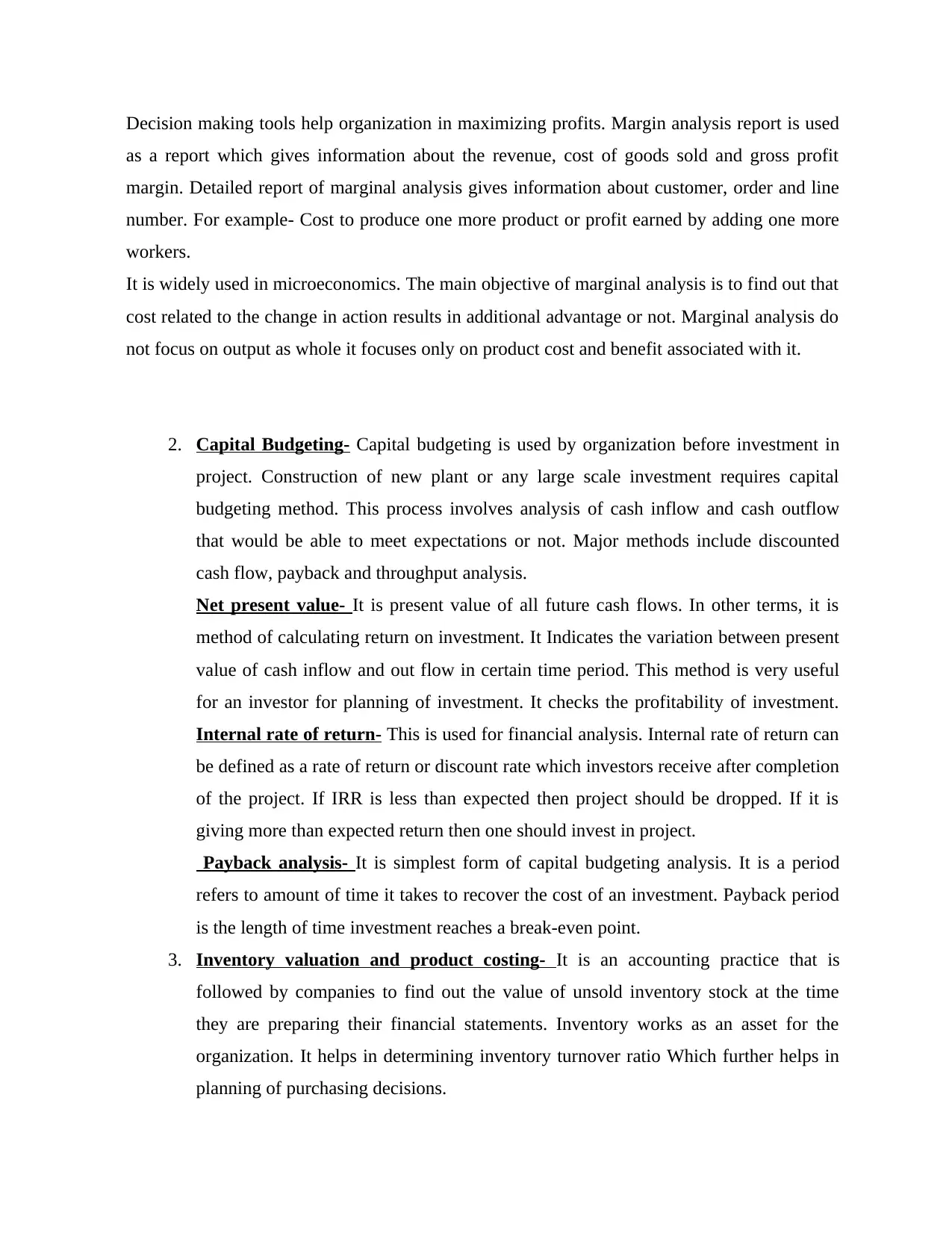
Decision making tools help organization in maximizing profits. Margin analysis report is used
as a report which gives information about the revenue, cost of goods sold and gross profit
margin. Detailed report of marginal analysis gives information about customer, order and line
number. For example- Cost to produce one more product or profit earned by adding one more
workers.
It is widely used in microeconomics. The main objective of marginal analysis is to find out that
cost related to the change in action results in additional advantage or not. Marginal analysis do
not focus on output as whole it focuses only on product cost and benefit associated with it.
2. Capital Budgeting- Capital budgeting is used by organization before investment in
project. Construction of new plant or any large scale investment requires capital
budgeting method. This process involves analysis of cash inflow and cash outflow
that would be able to meet expectations or not. Major methods include discounted
cash flow, payback and throughput analysis.
Net present value- It is present value of all future cash flows. In other terms, it is
method of calculating return on investment. It Indicates the variation between present
value of cash inflow and out flow in certain time period. This method is very useful
for an investor for planning of investment. It checks the profitability of investment.
Internal rate of return- This is used for financial analysis. Internal rate of return can
be defined as a rate of return or discount rate which investors receive after completion
of the project. If IRR is less than expected then project should be dropped. If it is
giving more than expected return then one should invest in project.
Payback analysis- It is simplest form of capital budgeting analysis. It is a period
refers to amount of time it takes to recover the cost of an investment. Payback period
is the length of time investment reaches a break-even point.
3. Inventory valuation and product costing- It is an accounting practice that is
followed by companies to find out the value of unsold inventory stock at the time
they are preparing their financial statements. Inventory works as an asset for the
organization. It helps in determining inventory turnover ratio Which further helps in
planning of purchasing decisions.
as a report which gives information about the revenue, cost of goods sold and gross profit
margin. Detailed report of marginal analysis gives information about customer, order and line
number. For example- Cost to produce one more product or profit earned by adding one more
workers.
It is widely used in microeconomics. The main objective of marginal analysis is to find out that
cost related to the change in action results in additional advantage or not. Marginal analysis do
not focus on output as whole it focuses only on product cost and benefit associated with it.
2. Capital Budgeting- Capital budgeting is used by organization before investment in
project. Construction of new plant or any large scale investment requires capital
budgeting method. This process involves analysis of cash inflow and cash outflow
that would be able to meet expectations or not. Major methods include discounted
cash flow, payback and throughput analysis.
Net present value- It is present value of all future cash flows. In other terms, it is
method of calculating return on investment. It Indicates the variation between present
value of cash inflow and out flow in certain time period. This method is very useful
for an investor for planning of investment. It checks the profitability of investment.
Internal rate of return- This is used for financial analysis. Internal rate of return can
be defined as a rate of return or discount rate which investors receive after completion
of the project. If IRR is less than expected then project should be dropped. If it is
giving more than expected return then one should invest in project.
Payback analysis- It is simplest form of capital budgeting analysis. It is a period
refers to amount of time it takes to recover the cost of an investment. Payback period
is the length of time investment reaches a break-even point.
3. Inventory valuation and product costing- It is an accounting practice that is
followed by companies to find out the value of unsold inventory stock at the time
they are preparing their financial statements. Inventory works as an asset for the
organization. It helps in determining inventory turnover ratio Which further helps in
planning of purchasing decisions.
⊘ This is a preview!⊘
Do you want full access?
Subscribe today to unlock all pages.

Trusted by 1+ million students worldwide
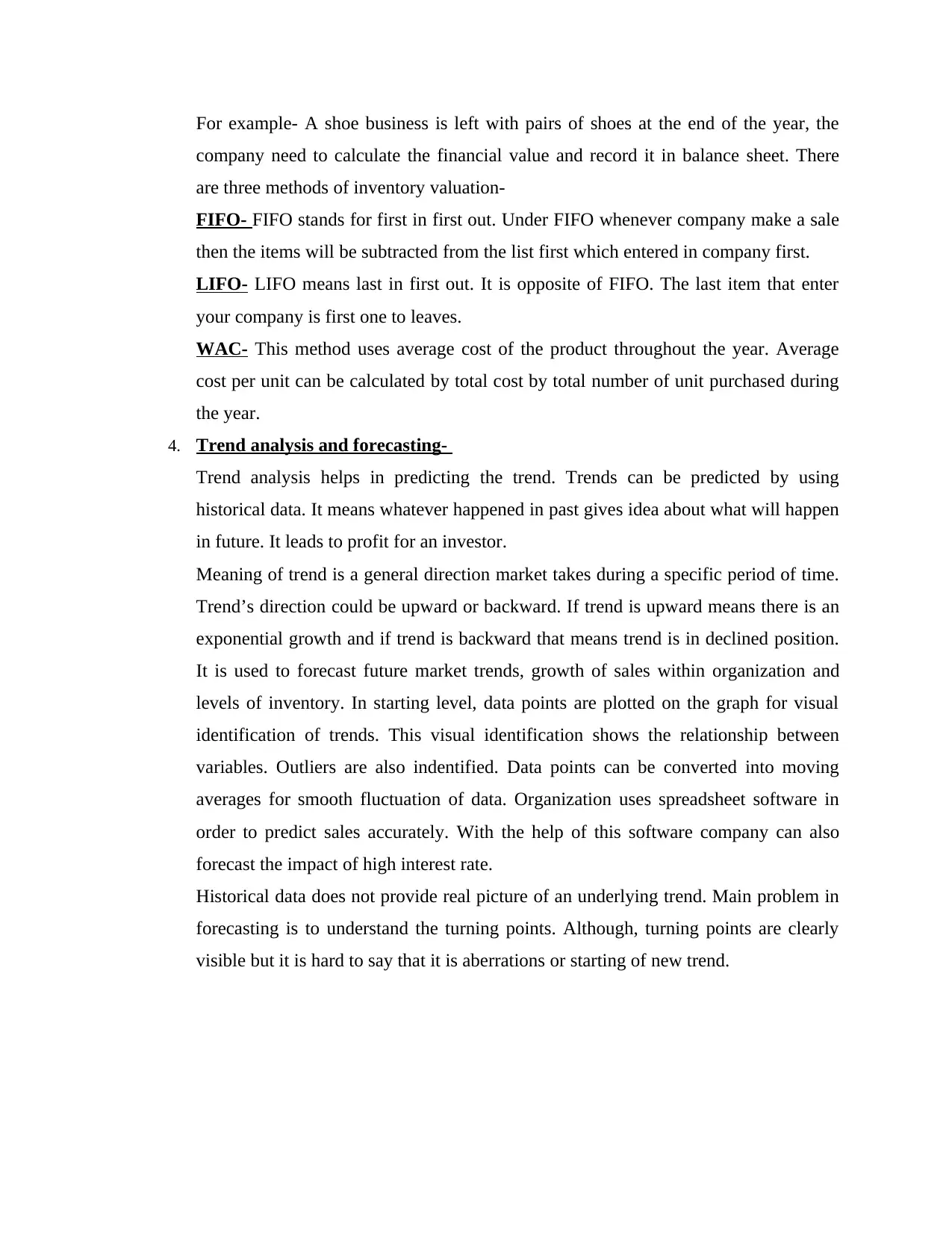
For example- A shoe business is left with pairs of shoes at the end of the year, the
company need to calculate the financial value and record it in balance sheet. There
are three methods of inventory valuation-
FIFO- FIFO stands for first in first out. Under FIFO whenever company make a sale
then the items will be subtracted from the list first which entered in company first.
LIFO- LIFO means last in first out. It is opposite of FIFO. The last item that enter
your company is first one to leaves.
WAC- This method uses average cost of the product throughout the year. Average
cost per unit can be calculated by total cost by total number of unit purchased during
the year.
4. Trend analysis and forecasting-
Trend analysis helps in predicting the trend. Trends can be predicted by using
historical data. It means whatever happened in past gives idea about what will happen
in future. It leads to profit for an investor.
Meaning of trend is a general direction market takes during a specific period of time.
Trend’s direction could be upward or backward. If trend is upward means there is an
exponential growth and if trend is backward that means trend is in declined position.
It is used to forecast future market trends, growth of sales within organization and
levels of inventory. In starting level, data points are plotted on the graph for visual
identification of trends. This visual identification shows the relationship between
variables. Outliers are also indentified. Data points can be converted into moving
averages for smooth fluctuation of data. Organization uses spreadsheet software in
order to predict sales accurately. With the help of this software company can also
forecast the impact of high interest rate.
Historical data does not provide real picture of an underlying trend. Main problem in
forecasting is to understand the turning points. Although, turning points are clearly
visible but it is hard to say that it is aberrations or starting of new trend.
company need to calculate the financial value and record it in balance sheet. There
are three methods of inventory valuation-
FIFO- FIFO stands for first in first out. Under FIFO whenever company make a sale
then the items will be subtracted from the list first which entered in company first.
LIFO- LIFO means last in first out. It is opposite of FIFO. The last item that enter
your company is first one to leaves.
WAC- This method uses average cost of the product throughout the year. Average
cost per unit can be calculated by total cost by total number of unit purchased during
the year.
4. Trend analysis and forecasting-
Trend analysis helps in predicting the trend. Trends can be predicted by using
historical data. It means whatever happened in past gives idea about what will happen
in future. It leads to profit for an investor.
Meaning of trend is a general direction market takes during a specific period of time.
Trend’s direction could be upward or backward. If trend is upward means there is an
exponential growth and if trend is backward that means trend is in declined position.
It is used to forecast future market trends, growth of sales within organization and
levels of inventory. In starting level, data points are plotted on the graph for visual
identification of trends. This visual identification shows the relationship between
variables. Outliers are also indentified. Data points can be converted into moving
averages for smooth fluctuation of data. Organization uses spreadsheet software in
order to predict sales accurately. With the help of this software company can also
forecast the impact of high interest rate.
Historical data does not provide real picture of an underlying trend. Main problem in
forecasting is to understand the turning points. Although, turning points are clearly
visible but it is hard to say that it is aberrations or starting of new trend.
Paraphrase This Document
Need a fresh take? Get an instant paraphrase of this document with our AI Paraphraser
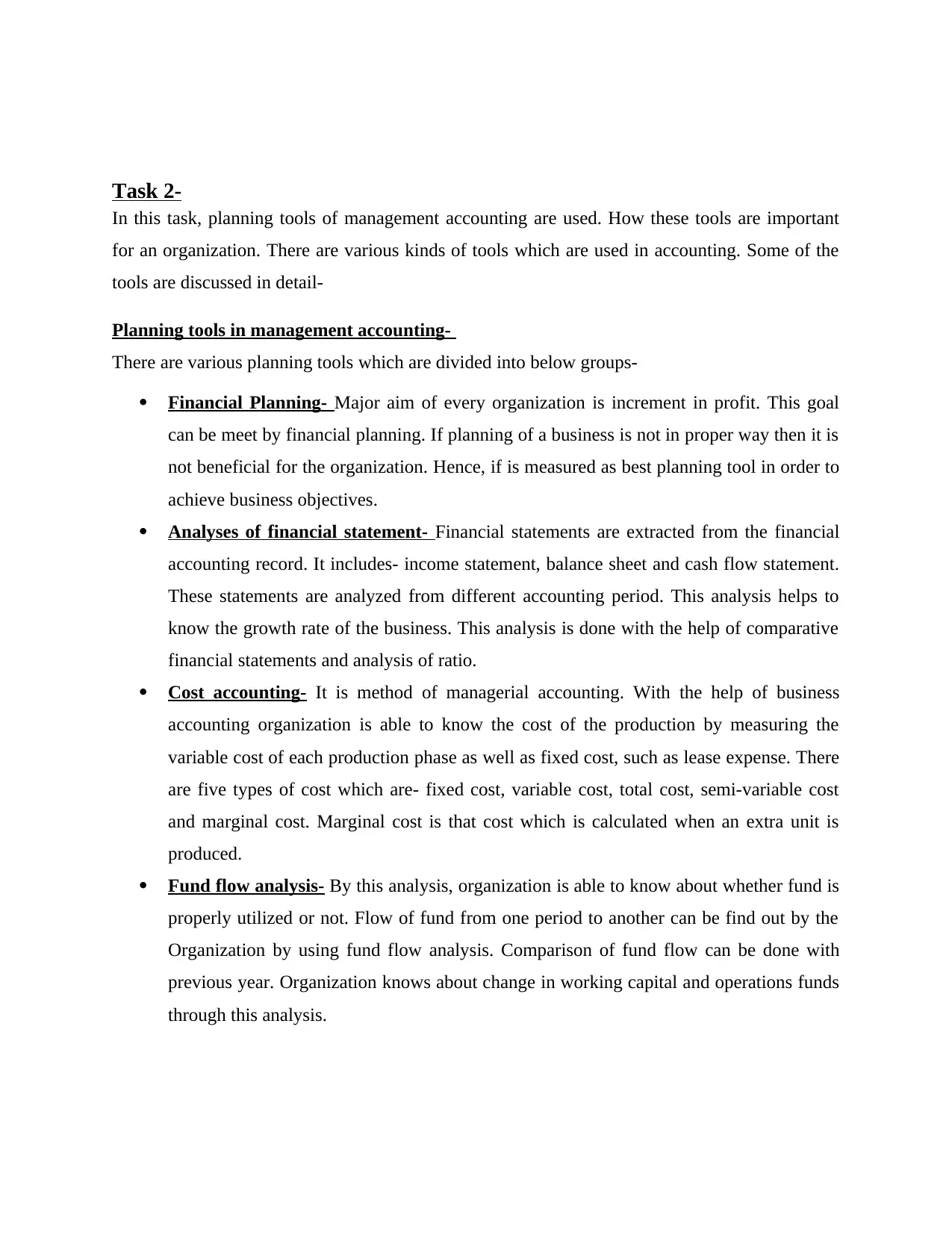
Task 2-
In this task, planning tools of management accounting are used. How these tools are important
for an organization. There are various kinds of tools which are used in accounting. Some of the
tools are discussed in detail-
Planning tools in management accounting-
There are various planning tools which are divided into below groups-
Financial Planning- Major aim of every organization is increment in profit. This goal
can be meet by financial planning. If planning of a business is not in proper way then it is
not beneficial for the organization. Hence, if is measured as best planning tool in order to
achieve business objectives.
Analyses of financial statement- Financial statements are extracted from the financial
accounting record. It includes- income statement, balance sheet and cash flow statement.
These statements are analyzed from different accounting period. This analysis helps to
know the growth rate of the business. This analysis is done with the help of comparative
financial statements and analysis of ratio.
Cost accounting- It is method of managerial accounting. With the help of business
accounting organization is able to know the cost of the production by measuring the
variable cost of each production phase as well as fixed cost, such as lease expense. There
are five types of cost which are- fixed cost, variable cost, total cost, semi-variable cost
and marginal cost. Marginal cost is that cost which is calculated when an extra unit is
produced.
Fund flow analysis- By this analysis, organization is able to know about whether fund is
properly utilized or not. Flow of fund from one period to another can be find out by the
Organization by using fund flow analysis. Comparison of fund flow can be done with
previous year. Organization knows about change in working capital and operations funds
through this analysis.
In this task, planning tools of management accounting are used. How these tools are important
for an organization. There are various kinds of tools which are used in accounting. Some of the
tools are discussed in detail-
Planning tools in management accounting-
There are various planning tools which are divided into below groups-
Financial Planning- Major aim of every organization is increment in profit. This goal
can be meet by financial planning. If planning of a business is not in proper way then it is
not beneficial for the organization. Hence, if is measured as best planning tool in order to
achieve business objectives.
Analyses of financial statement- Financial statements are extracted from the financial
accounting record. It includes- income statement, balance sheet and cash flow statement.
These statements are analyzed from different accounting period. This analysis helps to
know the growth rate of the business. This analysis is done with the help of comparative
financial statements and analysis of ratio.
Cost accounting- It is method of managerial accounting. With the help of business
accounting organization is able to know the cost of the production by measuring the
variable cost of each production phase as well as fixed cost, such as lease expense. There
are five types of cost which are- fixed cost, variable cost, total cost, semi-variable cost
and marginal cost. Marginal cost is that cost which is calculated when an extra unit is
produced.
Fund flow analysis- By this analysis, organization is able to know about whether fund is
properly utilized or not. Flow of fund from one period to another can be find out by the
Organization by using fund flow analysis. Comparison of fund flow can be done with
previous year. Organization knows about change in working capital and operations funds
through this analysis.
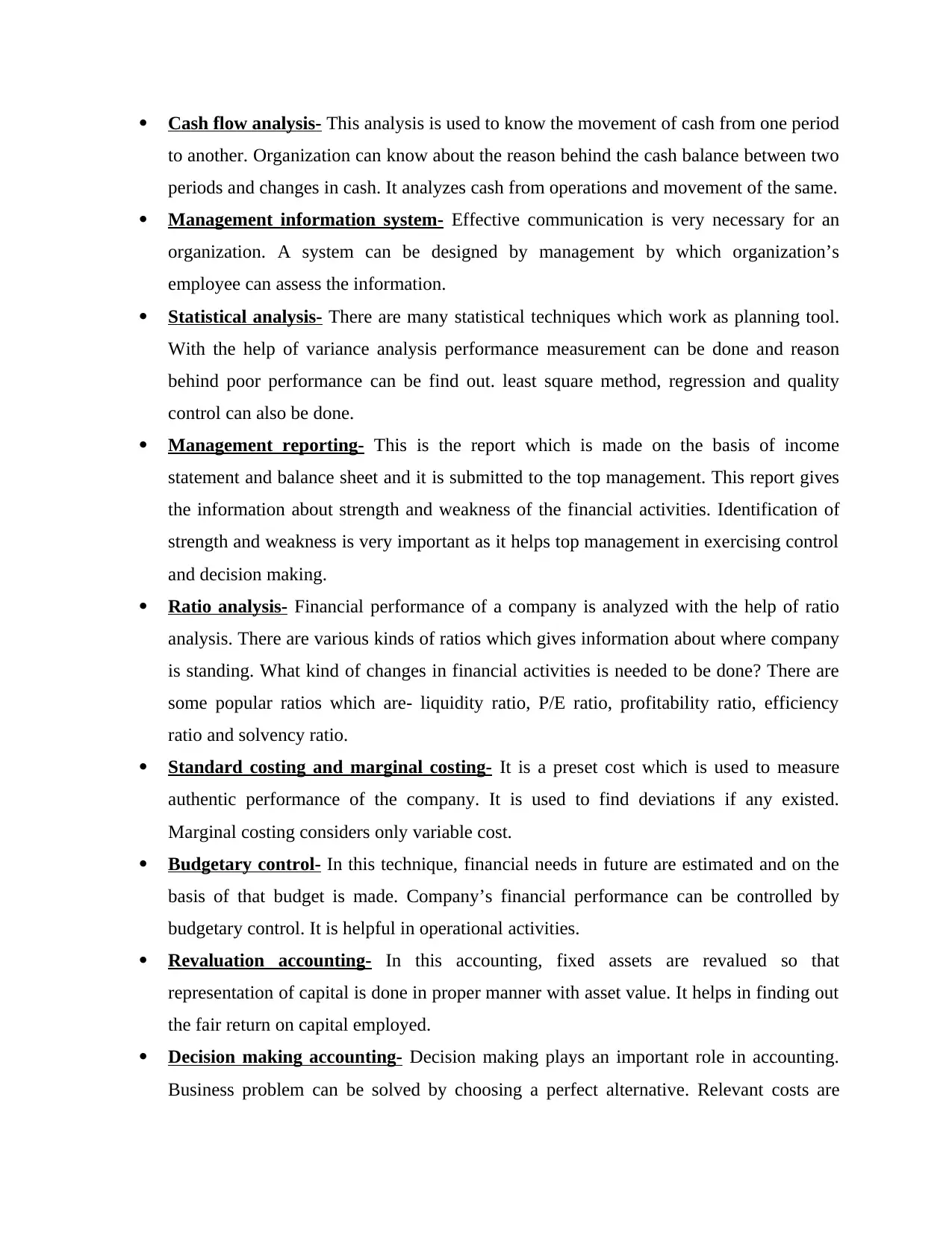
Cash flow analysis- This analysis is used to know the movement of cash from one period
to another. Organization can know about the reason behind the cash balance between two
periods and changes in cash. It analyzes cash from operations and movement of the same.
Management information system- Effective communication is very necessary for an
organization. A system can be designed by management by which organization’s
employee can assess the information.
Statistical analysis- There are many statistical techniques which work as planning tool.
With the help of variance analysis performance measurement can be done and reason
behind poor performance can be find out. least square method, regression and quality
control can also be done.
Management reporting- This is the report which is made on the basis of income
statement and balance sheet and it is submitted to the top management. This report gives
the information about strength and weakness of the financial activities. Identification of
strength and weakness is very important as it helps top management in exercising control
and decision making.
Ratio analysis- Financial performance of a company is analyzed with the help of ratio
analysis. There are various kinds of ratios which gives information about where company
is standing. What kind of changes in financial activities is needed to be done? There are
some popular ratios which are- liquidity ratio, P/E ratio, profitability ratio, efficiency
ratio and solvency ratio.
Standard costing and marginal costing- It is a preset cost which is used to measure
authentic performance of the company. It is used to find deviations if any existed.
Marginal costing considers only variable cost.
Budgetary control- In this technique, financial needs in future are estimated and on the
basis of that budget is made. Company’s financial performance can be controlled by
budgetary control. It is helpful in operational activities.
Revaluation accounting- In this accounting, fixed assets are revalued so that
representation of capital is done in proper manner with asset value. It helps in finding out
the fair return on capital employed.
Decision making accounting- Decision making plays an important role in accounting.
Business problem can be solved by choosing a perfect alternative. Relevant costs are
to another. Organization can know about the reason behind the cash balance between two
periods and changes in cash. It analyzes cash from operations and movement of the same.
Management information system- Effective communication is very necessary for an
organization. A system can be designed by management by which organization’s
employee can assess the information.
Statistical analysis- There are many statistical techniques which work as planning tool.
With the help of variance analysis performance measurement can be done and reason
behind poor performance can be find out. least square method, regression and quality
control can also be done.
Management reporting- This is the report which is made on the basis of income
statement and balance sheet and it is submitted to the top management. This report gives
the information about strength and weakness of the financial activities. Identification of
strength and weakness is very important as it helps top management in exercising control
and decision making.
Ratio analysis- Financial performance of a company is analyzed with the help of ratio
analysis. There are various kinds of ratios which gives information about where company
is standing. What kind of changes in financial activities is needed to be done? There are
some popular ratios which are- liquidity ratio, P/E ratio, profitability ratio, efficiency
ratio and solvency ratio.
Standard costing and marginal costing- It is a preset cost which is used to measure
authentic performance of the company. It is used to find deviations if any existed.
Marginal costing considers only variable cost.
Budgetary control- In this technique, financial needs in future are estimated and on the
basis of that budget is made. Company’s financial performance can be controlled by
budgetary control. It is helpful in operational activities.
Revaluation accounting- In this accounting, fixed assets are revalued so that
representation of capital is done in proper manner with asset value. It helps in finding out
the fair return on capital employed.
Decision making accounting- Decision making plays an important role in accounting.
Business problem can be solved by choosing a perfect alternative. Relevant costs are
⊘ This is a preview!⊘
Do you want full access?
Subscribe today to unlock all pages.

Trusted by 1+ million students worldwide
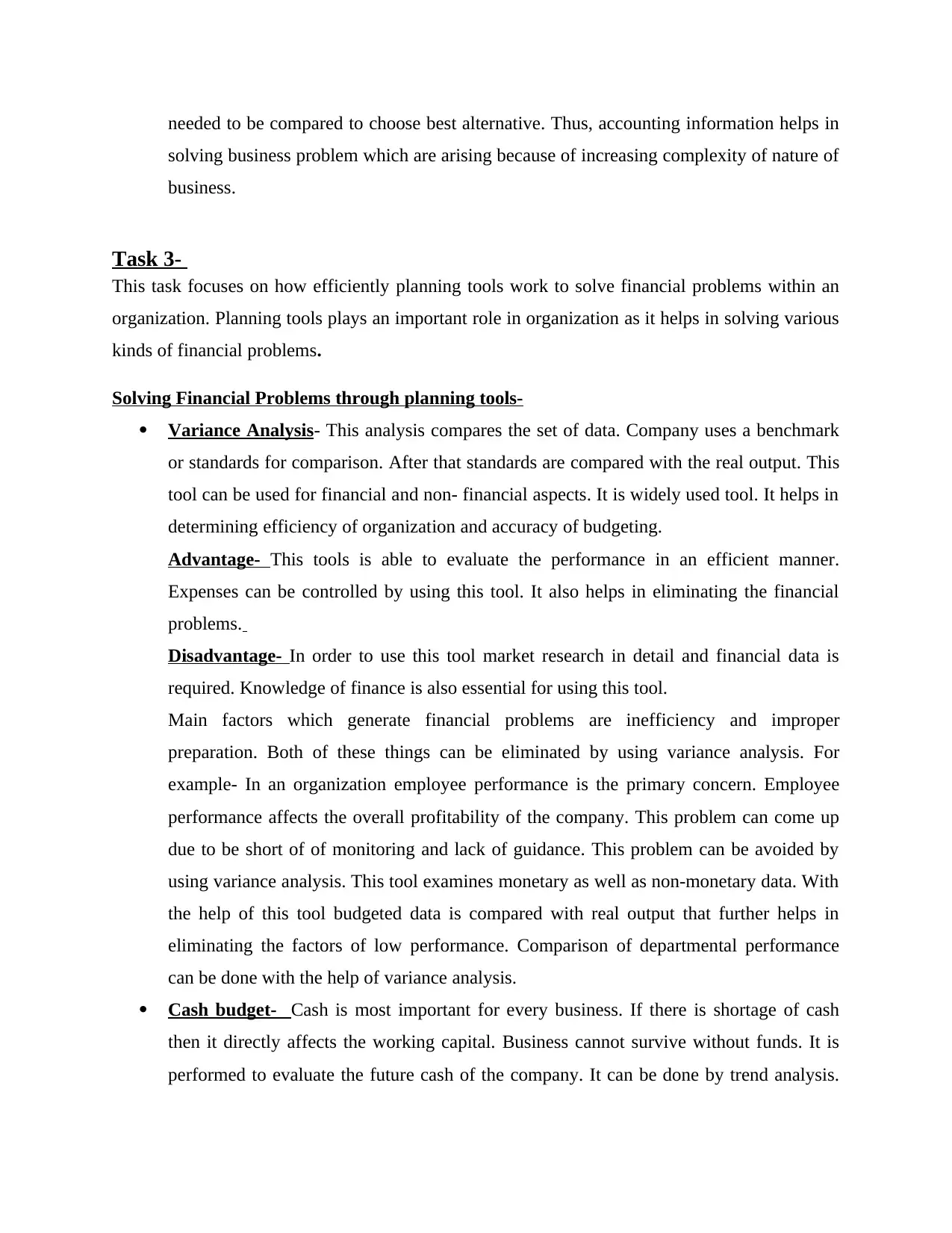
needed to be compared to choose best alternative. Thus, accounting information helps in
solving business problem which are arising because of increasing complexity of nature of
business.
Task 3-
This task focuses on how efficiently planning tools work to solve financial problems within an
organization. Planning tools plays an important role in organization as it helps in solving various
kinds of financial problems.
Solving Financial Problems through planning tools-
Variance Analysis- This analysis compares the set of data. Company uses a benchmark
or standards for comparison. After that standards are compared with the real output. This
tool can be used for financial and non- financial aspects. It is widely used tool. It helps in
determining efficiency of organization and accuracy of budgeting.
Advantage- This tools is able to evaluate the performance in an efficient manner.
Expenses can be controlled by using this tool. It also helps in eliminating the financial
problems.
Disadvantage- In order to use this tool market research in detail and financial data is
required. Knowledge of finance is also essential for using this tool.
Main factors which generate financial problems are inefficiency and improper
preparation. Both of these things can be eliminated by using variance analysis. For
example- In an organization employee performance is the primary concern. Employee
performance affects the overall profitability of the company. This problem can come up
due to be short of of monitoring and lack of guidance. This problem can be avoided by
using variance analysis. This tool examines monetary as well as non-monetary data. With
the help of this tool budgeted data is compared with real output that further helps in
eliminating the factors of low performance. Comparison of departmental performance
can be done with the help of variance analysis.
Cash budget- Cash is most important for every business. If there is shortage of cash
then it directly affects the working capital. Business cannot survive without funds. It is
performed to evaluate the future cash of the company. It can be done by trend analysis.
solving business problem which are arising because of increasing complexity of nature of
business.
Task 3-
This task focuses on how efficiently planning tools work to solve financial problems within an
organization. Planning tools plays an important role in organization as it helps in solving various
kinds of financial problems.
Solving Financial Problems through planning tools-
Variance Analysis- This analysis compares the set of data. Company uses a benchmark
or standards for comparison. After that standards are compared with the real output. This
tool can be used for financial and non- financial aspects. It is widely used tool. It helps in
determining efficiency of organization and accuracy of budgeting.
Advantage- This tools is able to evaluate the performance in an efficient manner.
Expenses can be controlled by using this tool. It also helps in eliminating the financial
problems.
Disadvantage- In order to use this tool market research in detail and financial data is
required. Knowledge of finance is also essential for using this tool.
Main factors which generate financial problems are inefficiency and improper
preparation. Both of these things can be eliminated by using variance analysis. For
example- In an organization employee performance is the primary concern. Employee
performance affects the overall profitability of the company. This problem can come up
due to be short of of monitoring and lack of guidance. This problem can be avoided by
using variance analysis. This tool examines monetary as well as non-monetary data. With
the help of this tool budgeted data is compared with real output that further helps in
eliminating the factors of low performance. Comparison of departmental performance
can be done with the help of variance analysis.
Cash budget- Cash is most important for every business. If there is shortage of cash
then it directly affects the working capital. Business cannot survive without funds. It is
performed to evaluate the future cash of the company. It can be done by trend analysis.
Paraphrase This Document
Need a fresh take? Get an instant paraphrase of this document with our AI Paraphraser
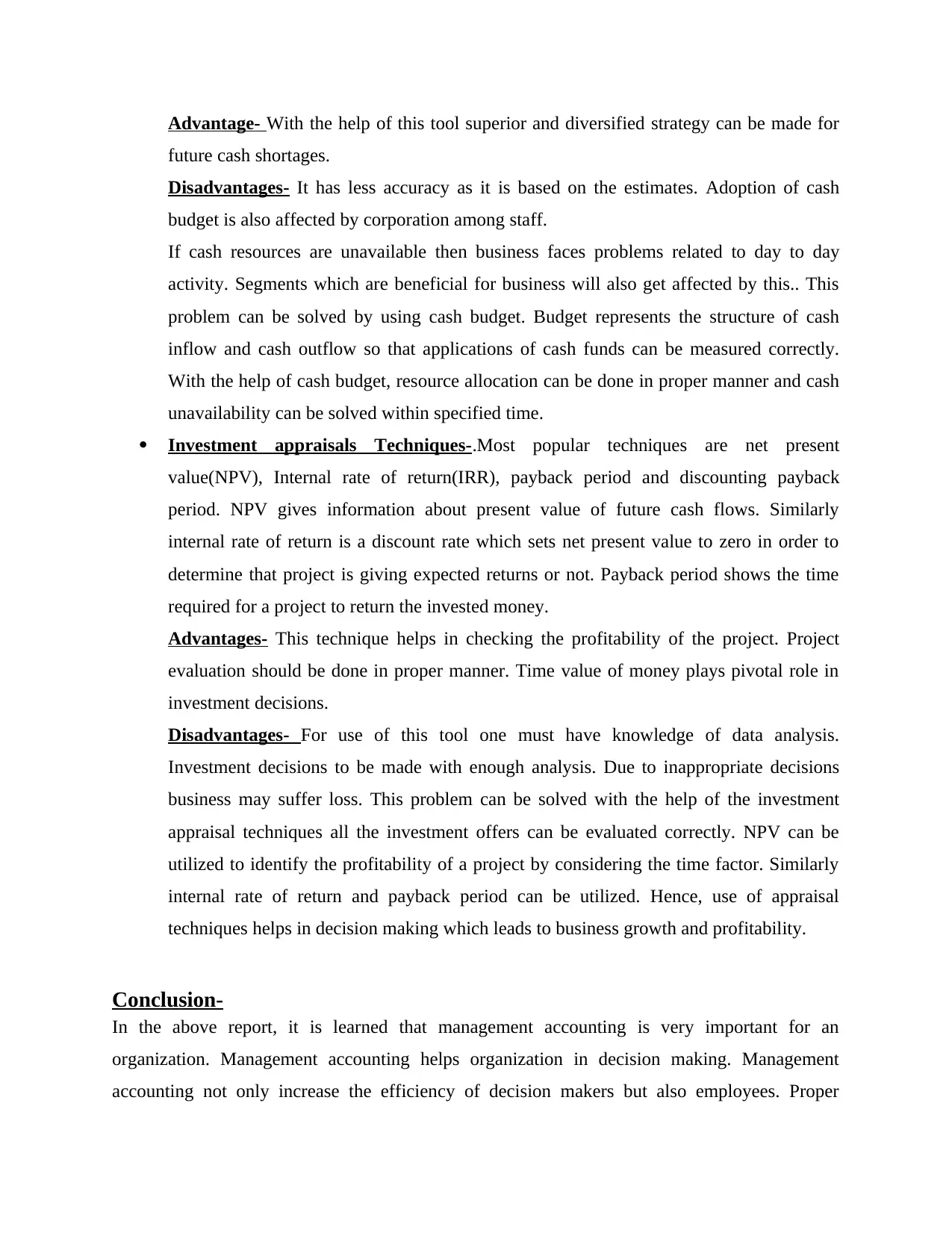
Advantage- With the help of this tool superior and diversified strategy can be made for
future cash shortages.
Disadvantages- It has less accuracy as it is based on the estimates. Adoption of cash
budget is also affected by corporation among staff.
If cash resources are unavailable then business faces problems related to day to day
activity. Segments which are beneficial for business will also get affected by this.. This
problem can be solved by using cash budget. Budget represents the structure of cash
inflow and cash outflow so that applications of cash funds can be measured correctly.
With the help of cash budget, resource allocation can be done in proper manner and cash
unavailability can be solved within specified time.
Investment appraisals Techniques-.Most popular techniques are net present
value(NPV), Internal rate of return(IRR), payback period and discounting payback
period. NPV gives information about present value of future cash flows. Similarly
internal rate of return is a discount rate which sets net present value to zero in order to
determine that project is giving expected returns or not. Payback period shows the time
required for a project to return the invested money.
Advantages- This technique helps in checking the profitability of the project. Project
evaluation should be done in proper manner. Time value of money plays pivotal role in
investment decisions.
Disadvantages- For use of this tool one must have knowledge of data analysis.
Investment decisions to be made with enough analysis. Due to inappropriate decisions
business may suffer loss. This problem can be solved with the help of the investment
appraisal techniques all the investment offers can be evaluated correctly. NPV can be
utilized to identify the profitability of a project by considering the time factor. Similarly
internal rate of return and payback period can be utilized. Hence, use of appraisal
techniques helps in decision making which leads to business growth and profitability.
Conclusion-
In the above report, it is learned that management accounting is very important for an
organization. Management accounting helps organization in decision making. Management
accounting not only increase the efficiency of decision makers but also employees. Proper
future cash shortages.
Disadvantages- It has less accuracy as it is based on the estimates. Adoption of cash
budget is also affected by corporation among staff.
If cash resources are unavailable then business faces problems related to day to day
activity. Segments which are beneficial for business will also get affected by this.. This
problem can be solved by using cash budget. Budget represents the structure of cash
inflow and cash outflow so that applications of cash funds can be measured correctly.
With the help of cash budget, resource allocation can be done in proper manner and cash
unavailability can be solved within specified time.
Investment appraisals Techniques-.Most popular techniques are net present
value(NPV), Internal rate of return(IRR), payback period and discounting payback
period. NPV gives information about present value of future cash flows. Similarly
internal rate of return is a discount rate which sets net present value to zero in order to
determine that project is giving expected returns or not. Payback period shows the time
required for a project to return the invested money.
Advantages- This technique helps in checking the profitability of the project. Project
evaluation should be done in proper manner. Time value of money plays pivotal role in
investment decisions.
Disadvantages- For use of this tool one must have knowledge of data analysis.
Investment decisions to be made with enough analysis. Due to inappropriate decisions
business may suffer loss. This problem can be solved with the help of the investment
appraisal techniques all the investment offers can be evaluated correctly. NPV can be
utilized to identify the profitability of a project by considering the time factor. Similarly
internal rate of return and payback period can be utilized. Hence, use of appraisal
techniques helps in decision making which leads to business growth and profitability.
Conclusion-
In the above report, it is learned that management accounting is very important for an
organization. Management accounting helps organization in decision making. Management
accounting not only increase the efficiency of decision makers but also employees. Proper

management should be implemented. Decision making is very important for organization. There
are various planning tools and techniques as well which help organization in growth.
Organization should use planning tools to eliminate the financial problems. Thus, it can be said
that functioning of business cannot be done properly without management accounting.
References-
Books and Journals-
Agustia, D. et. al, , W., 2019. The mediating effect of environmental management accounting on
green innovation-Firm value relationship. International Journal of Energy Economics and
Policy, 9(2), pp.299-306.
Brewer, P.C., et. al, E.W., 2015. Managerial accounting (p. 832). McGraw-Hill Create.
Chibili, M., 2019. Basic management accounting for the hospitality industry. Routledge.
Christensen, B. and Himme, A., 2017. Improving environmental management accounting: how
to use statistics to better determine energy consumption. Journal of Management Control, 28(2),
pp.227-243.
Goddard, A. and Simm, A., 2017. Management accounting, performance measurement and
strategy in English local authorities. Public Money & Management, 37(4), pp.261-268.
Mazarak, A. and Fomina, O., 2016. Tools for management accounting. Economic Annals-
XXI, 159(5-6), pp.48-51.
Mitter, C. and Hiebl, M.R., 2017. The role of management accounting in international
entrepreneurship. Journal of Accounting & Organizational Change.
Setiawan, et. al., 2019. Owner power, deliberate strategy formulation, and strategic management
accounting. Opcion, 35(89), pp.254-270.
Sokolov, A.Y. and Giniatullin, Y.M., 2015. Management accounting and costs controlling in oil
producing companies: Historical perspectives. Mediterranean Journal of Social Sciences, 6(1
S3), p.430.
Verma, M., 2015. Inventory management accounting for obsolete inventory. IUP Journal of
Accounting Research & Audit Practices, 14(1), p.55.
Wickramasinghe, D., 2015. Getting management accounting off the ground: Post-colonial
neoliberalism in healthcare budgets. Accounting and Business Research, 45(3), pp.323-355.
are various planning tools and techniques as well which help organization in growth.
Organization should use planning tools to eliminate the financial problems. Thus, it can be said
that functioning of business cannot be done properly without management accounting.
References-
Books and Journals-
Agustia, D. et. al, , W., 2019. The mediating effect of environmental management accounting on
green innovation-Firm value relationship. International Journal of Energy Economics and
Policy, 9(2), pp.299-306.
Brewer, P.C., et. al, E.W., 2015. Managerial accounting (p. 832). McGraw-Hill Create.
Chibili, M., 2019. Basic management accounting for the hospitality industry. Routledge.
Christensen, B. and Himme, A., 2017. Improving environmental management accounting: how
to use statistics to better determine energy consumption. Journal of Management Control, 28(2),
pp.227-243.
Goddard, A. and Simm, A., 2017. Management accounting, performance measurement and
strategy in English local authorities. Public Money & Management, 37(4), pp.261-268.
Mazarak, A. and Fomina, O., 2016. Tools for management accounting. Economic Annals-
XXI, 159(5-6), pp.48-51.
Mitter, C. and Hiebl, M.R., 2017. The role of management accounting in international
entrepreneurship. Journal of Accounting & Organizational Change.
Setiawan, et. al., 2019. Owner power, deliberate strategy formulation, and strategic management
accounting. Opcion, 35(89), pp.254-270.
Sokolov, A.Y. and Giniatullin, Y.M., 2015. Management accounting and costs controlling in oil
producing companies: Historical perspectives. Mediterranean Journal of Social Sciences, 6(1
S3), p.430.
Verma, M., 2015. Inventory management accounting for obsolete inventory. IUP Journal of
Accounting Research & Audit Practices, 14(1), p.55.
Wickramasinghe, D., 2015. Getting management accounting off the ground: Post-colonial
neoliberalism in healthcare budgets. Accounting and Business Research, 45(3), pp.323-355.
⊘ This is a preview!⊘
Do you want full access?
Subscribe today to unlock all pages.

Trusted by 1+ million students worldwide
1 out of 13
Related Documents
Your All-in-One AI-Powered Toolkit for Academic Success.
+13062052269
info@desklib.com
Available 24*7 on WhatsApp / Email
![[object Object]](/_next/static/media/star-bottom.7253800d.svg)
Unlock your academic potential
Copyright © 2020–2025 A2Z Services. All Rights Reserved. Developed and managed by ZUCOL.





